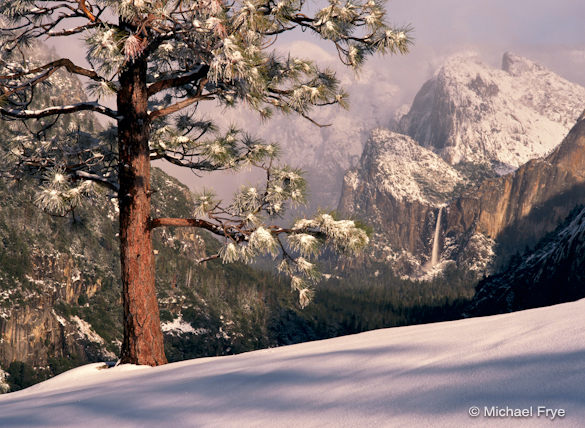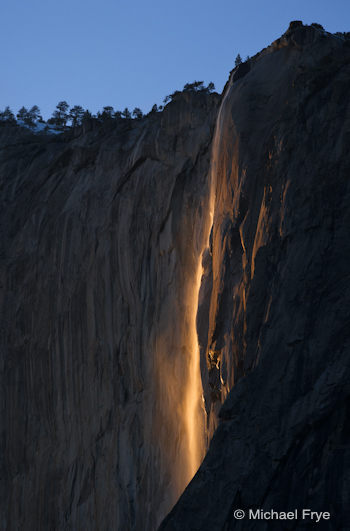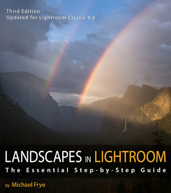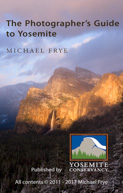by Michael Frye | Feb 12, 2012 | Yosemite Photo Conditions

February light on Bridalveil Fall from near Turtleback Dome
First, I’m going to have a big announcement later this week—stay tuned!
Next, I’ve been getting lots of questions about Horsetail Fall. Since my last post about this not much has changed; there is little water in Horsetail right now. There’s snow in the forecast for tonight and tomorrow, so that should help, but they’re only predicting 6-8 inches, and I don’t know whether that will be enough to make a significant difference. If the weather warms immediately afterward and melts some of that new snow the water volume could get a bump, but it’s likely to be short-lived.
But there are other things to photograph in Yosemite in February. That storm is predicted to be a cold one, which means fresh snow in Yosemite Valley. And when the storm ends we could see some nice clearing storm conditions.
(more…)
by Michael Frye | Feb 8, 2011 | Yosemite Photo Conditions

Horsetail Fall, February 22nd, 2010
It’s here—almost. The window of best light on Horsetail Fall will begin around February 12th and continue until approximately February 22nd this year. The big questions is how much water will be in the fall.
Horsetail Fall is fed by snow melting from a small area on top of El Capitan. While there was plenty of snow up there in December, we’ve had only one small storm since January 2nd, and much of that early-winter snowpack has disappeared. Horsetail has a decent flow right now, indicating that there’s still some snow on top of El Cap, and I think there will be enough to last through the window of best light—but it might be a close call. If the snowpack holds up, and the warm, dry weather continues, it could be a banner year for Horsetail Fall photographs, with many clear sunsets.
For more details about photographing Horsetail Fall, see this article on my web site, or previous blog posts here and here. And check out the time-lapse video of Horsetail that Steve Bumgardner just posted.
Meanwhile, Yosemite Falls is still going strong, with exceptionally high flow for February, and excellent early-morning light. That light starts to shift soon—by the end of the month it’s not nearly as good. But for the next week or so the sun will strike the upper fall early, creating golden light on the water, and the chance to see rainbows from the eastern end of Cook’s Meadow.
Just to make things more interesting, there will be a full moon the night of February 17th, right in the middle of the Horsetail window. In Yosemite Valley the best opportunities for moonrise photos occur one to three days before the actual full moon date. I recommend using The Photographer’s Ephemeris to figure out the the specifics, but it looks like the moon might be visible near Half Dome at sunset on the 15th from the eastern end of the valley (Cook’s Meadow and the Ahwahnee Meadow). The evening of the 16th you might be able to see a moonrise from Tunnel View. So if you’re in Yosemite one of those days you’ll have to choose between trying to photograph Horsetail Fall or the moonrise.
If you get any good photographs of Horsetail, a moonrise, or anything else in the park, I’d love to see them, so please feel free to post links in the comments. Good luck!
by Michael Frye | Feb 28, 2009 | Yosemite Photo Conditions

It’s still winter in Yosemite, but spring has arrived at lower elevations. Poppies have exploded along the Merced River west of the park. They’re blooming across the river from Highway 140 between Briceburg and the rock-slide detour. The largest, densest patches have sprouted in places burned by the Telegraph Fire last summer, although other poppies are starting to appear in the usual spots further east in the canyon.
I used a 200mm lens to make the image above on my way back from Yosemite this morning. Unfortunately there’s no easy access to the poppies from 140, as they’re all on the opposite side of the river, but it’s possible to photograph them from near the road with long lenses.
The best light on Horsetail Fall is over. In early February the water flow in Horsetail was too low for good photographs. Later in the month the flow increased, but clouds blocked every sunset except one, on February 19th. Consider yourself lucky if you photographed it that day! There were many disappointed photographers in Yosemite this past month. The light on Horsetail in early March can be nice, with a golden glow late in the day, but it’s not the neon orange light that everyone is after.
Water volume in all the Yosemite waterfalls is gradually increasing, and should continue to increase during March and April. A lot of snow has melted, although most of the valley floor is still snow-covered. The forecast is calling for a series of storms next week, which is good news, as we still need more rain and snow.
by Michael Frye | Feb 2, 2009 | Photography Tips, Yosemite Photo Conditions
 Conditions haven’t changed much since my post from January 19th. Most of the valley floor has old snow, with breakable crust that’s hard to walk on. But of course there are always things to photograph.
Conditions haven’t changed much since my post from January 19th. Most of the valley floor has old snow, with breakable crust that’s hard to walk on. But of course there are always things to photograph.
During winter here in the northern hemisphere the sun rises from the southeast and sets to the southwest. In Yosemite Valley this means that the rock formations on the north side of the valley, like El Capitan, Three Brothers (right), and Yosemite Falls, get hit by the sun early and late in the day, while the south side of the valley, including Sentinel Rock, Cathedral Rocks, and Bridalveil Fall, gets little sunlight. Half Dome receives nice sunset light all year, but in winter this late-day illumination rakes across its face, amplifying the texture of the rock.
February is a transition month as we approach spring. Sentinel Rock and Bridalveil Fall start to get some late-day light. The waterfalls have just a little more flow than in December and January. In February Upper Yosemite Fall often has a nice combination of early morning sun and a decent amount of water. Of course there’s the famous sunset light on Horsetail Fall.
The forecast calls for rain and higher elevation snow later this week. Storms, whether they bring rain or snow, always provide opportunities for great clearing storm photographs.












